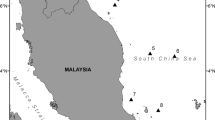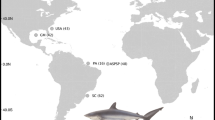Abstract
Restriction fragment length polymorphism (RFLP) analysis of mitochondrial DNA (mtDNA) was used to investigate the taxonomic status of the following species-pairs of Atlantic and Indo-Pacific istiophorid billfishes: Atlantic blue marlin Makaira nigricans (Lacépède) and Indo-Pacific blue marlin M. mazara (Jordan and Snyder); Atlantic sailfish Istiophorus albicans (Latreille) and Indo-Pacific sailfish I. platypterus (Shaw and Nodder); and white marlin Tetrapturus albidus Poey and striped marlin T. audax (Phillippi). Tissue samples were collected from 1990 to 1992. Several mtDNA haplotypes were common to Atlantic and Indo-Pacific samples of blue marlin and sailfish, although there were significant differences in the distribution of haplotypes between samples from different oceans. For both blue marlin and sailfish, a single group of closely related mtDNA haplotypes was found among all indo-Pacific and some Atlantic individuals, while the remaining Atlantic specimens exhibited mtDNA haplotypes that differed by several consistent restriction site changes from the common haplotype. No restriction site differences were found to discriminate white marlin from striped marlin, and the mtDNA haplotypes of both species were very similar although significant differences were found in the distribution of haplotypes between the two species. Two of 26 haplotypes were shared between white and striped marlin, and the corrected mean nucleotide sequence divergence between species (0.06%) was not much greater than that observed between geographically distant samples of striped marlin from the Pacific Ocean (mean 0.03%). The presence of identical haplotypes in samples from both oceans for each of the three species-pairs of istiophorid billfishes suggests that specific status may not be warranted for any of the Atlantic and Indo-Pacific populations. The significant difference in the distributions of mtDNA haplotypes between Atlantic and Indo-Pacific populations, which contrasts sharply with the homogeneity reported for several species of tunas, indicates considerable population structuring within the highly vagile billfishes.
Similar content being viewed by others
References
Avise JC, Arnold J, Ball RM, Bermingham E, Lamb T, Neigel JE, Reeb CA, Saunders NC (1987) Intraspecific phylogeography: the mitochondrial DNA bridge between population genetics and systematics. Rev Ecol Syst 18:489–522
Block BA, Finnerty JR, Stewart AFR, Kidd J (1993) Evolution of endothermy in fish: mapping physiological traits on a molecular phylogeny. Science NY 260:210–214
Bowen BW, Avise JC 81990) Genetic structure of Atlantic and Gulf of Mexico populations of sea bass, menhaden, and sturgeon: influence of zoogeographic factors and life-history patterns. Mar Biol 107:371–381
Briggs JC 81960) Fishes of worldwide (circumtropical) distribution. copeia 1960:371–381
Gollette BB, Nauen CE (1983) FAO species catalogue, Vol. 2. Scombrids of the world: an annotated and illustrated catalogue of tunas, mackerels, bonitos and related species known to date. FAO Fish Biol Synopses 125
Crosetti D, Avise JC, Placidi F, Rossi AR, Sola L (1993) Geographic variability in the grey mullet Mugil cephalus: preliminary results of mtDNA and chromosome analyses. Aquaculture, Amsterdam 111:95–101
Dodson JJ, Carscadden JE, Bernatchez L, Colombani F (1991) Relationship between spawning mode and phylogeographic structure in mitochondrial DNA of North Atlantic capelin Mallotus villosus. Mar Ecol Prog Ser 76:103–113
FAO (Food and Agriculture Organization of the United Nations) (1992) Yearbook of fisheries statistics. Catches and landings, 1990. Yearbook Fish Stats, Vol. 70, FAO, Rome
Farris JS (1986) Hennig 86, version 1.5. Software distributed by Arnold Kluge, Dept. of Reptiles and Amphibians, Museum of Zoology, University of Michigan, Ann Arbor, Michigan
Finnerty JR, Block BA (1992) Direct sequencing of mitochondrial DNA detects highly divergent haplotypes in blue marlin (Makaira nigricans). Molec mar Biol Biotechnol 1:206–214
Fujino K (1969) Atlantic skipjack tuna genetically distinct from Pacific specimens. Copeia 1969:626–629
Fujino K, Sasaki K, Okumura S (1981) Genetic diversity of skipjack tuna in the Atlantic, Indian, and Pacific Oceans. Bull Jap Soc scient Fish 47:215–222
Graves JE, Curtis MJ, Oeth PA, Waples RS (1990) Biochemical genetics of southern California basses of the genus Paralabrax: specific identification of fresh and ethanol-preserved individual eggs and early larvae. Fish Bull US 88:59–66
Graves JE, Dizon AE (1989) Mitochondrial DNA sequence similarity of Atlantic and Pacific albacore tuna. Can J fish aquat Sciences 46:870–873
Graves JE, Ferris SD, Dizon AE (1984) High genetic similarity of Atlantic and Pacific skipjack tuna demonstrated with restriction endonuclease analysis of mitochondrial DNA. Mar Biol 79:315–319
Graves JE, McDowell JR (1994) Genetic analysis of striped marlin Tetrapturus audax population structure in the Pacific Ocean. Can J Fish aquat Sciences 51:1762–1768
Graves JE, McDowell JR, Beardsley AM, Scoles DR (1992) Stock structure of the bluefish Pomatomus saltatrix along the mid-Atlantic coast. Fish Bull US 90:703–710
Lansman RA, Avise JC, Aquadro CF, Shapira JF, Daniel SW (1981) The use of restriction endonucleases to measure mtDNA sequence relatedness in natural populations. III. Techniques and potential applications. J molec Evolut 17:214–226
McEIroy D, Moran P, Bermingham E, Kornfield I (1992) REAP —the restriction enzyme analysis package. J Hered 83:157–158
Morgan LW (1992) Allozyme analysis of billfish population structure. M.A. Thesis, Virginia Institute of Marine Science, College of Williams and Mary, Gloucester Point, Virginia
Morrow JE, Harbo SJ (1969) A revision of the sailfish genus Istiophorus. Copeia 1969:34–44
Nakamura I (1985) FAO species catalogue, Vol. 5. Billfishes of the world: an annotated and illustrated catalogue of marlins, sailfishes, spearfishes and swordfishes known to date. FAO Fish Biol Synposes 125
Nei M (1987) Molecular evolutionary genetics. Columbia University Press, New York
Nei M, Miller JC (1990) A simple method for estimating average number of nucleotide substitutions within and between populations from restriction site data. Genetics 125:873–879
Norusis ML (1988) SPSS-X advanced statistics guide, 2nd edn. SPSS Inc., Chicago, Illinois
Patton JL, Smith MF (1994) Paraphyly, polyphyly, and the nature of species boundaries in pocket gophers (genus Thomomys). Syst Biol 4:11–26
Rivas LR (1975) Synopsis of biological data on blue marlin, Makaira nigricans Lacepede, 1802. In: Shomura RS, Williams F (eds) Proceedings of the International Billfish Symposium, Kailua-Kona, Hawaii, part 3. US Dept Commer, NOAA Tech Rep NMFS SSRF-675, pp 1–16
Robins CR (1974) The validity and status of the roundscale spearfish, Tetrapturus georgei Robins and de Sylva. In: Shomura RS, Williams F (eds) Proceedings of the International Billfish Symposium, Kailua-Kona, Hawaii, part 2. US Dept Commer, NOAA Tech Rep NMFS SSRF-675, pp 54–61
Robins CR, de Sylva DP (1960) Description and relationships of the longbill spearfish, Tetrapturus belone, based on western North Atlantic specimens. Bull mar Sci 10:383–413
Roff DA, Bertzen P (1989) The statistical analysis of mitochondrial DNA polymorphisms: χ2 and the problem of small samples. Molec Biol Evol 6:539–545
Sambrook J, Fritsch EF, Maniatis T (1989) Molecular cloning: a laboratory manual, 2nd edn. Cold Spring Harbor Laboratory Press, Cold Spring Harbor, New York
Scoles DR, Graves JE (1993) Genetic analysis of the population structure of yellowfin tuna Thunnus albacares in the Pacific Ocean. Fish Bull US 91:690–698
Scott EL, Prince ED, Goodyear CD (1990) History of the cooperative game fish tagging program in the Atlantic Ocean, Gulf of Mexico, and Caribbean Sea, 1954–1987. Am Fish Soc Symp 7:841–853
Squire JL, Suzuki Z (1990) Migration trends of striped marlin (Tetrapturus audax) in the Pacific Ocean. In: Stroud RH (ed) Planning the future of billfishes: research and management in the 90s and beyond. National Coalition for Marine Conservation, Inc. Savannah, Georgia, pp 67–80
Talbot FH, Penrith MJ (1962) Tunnies and marlins of South Africa. Nature, Lond 193:558–559
Ward RD, Elliot NG, Grewe PM, Smolenski AJ (1994) Allozyme and mitochondrial DNA variation in yellowfin tuna (Thunnus albacares) from the Pacific Ocean. Mar Biol 118:531–539
Witzell WN, Scott EL (1990) Blue marlin, Makaira nigricans, movements in the western north Atlantic Ocean: results of a cooperative game fish tagging program, 1954–88. Mar Fish Rev 52: 12–17
Author information
Authors and Affiliations
Additional information
Communicated by J. P. Grassle, New Brunswick
Rights and permissions
About this article
Cite this article
Graves, J.E., McDowell, J.R. Inter-ocean genetic divergence of istiophorid billfishes. Marine Biology 122, 193–203 (1995). https://doi.org/10.1007/BF00348932
Received:
Accepted:
Issue Date:
DOI: https://doi.org/10.1007/BF00348932




